About The Author
Hello! From Chuchura (in Hooghly District) and a foodie, I created this blog with a mission to preserve the food of the land; with a message to encourage and promote clean and real food. I hope you enjoy and gain out of this blog, happy reading!
Looking forward to read and hear your feedback.
If you are from Bengal, you must be well-aware of Gobindobhog rice. Not just Bengal, even Odisha is well-accustomed to this variety of rice that is used in abundance.
And in case you are someone who chanced upon this without an iota of what the fuss is all about, I assure you that by the time you reach the end of this article, you will have a fair idea about it and how to use the rice to whip up one-pot delicacies in your kitchen.
Gobindobhog rice is a short-grain, white, aromatic, sticky rice according to Wikipedia.
The rice is widely used in preparation of dishes on special occasions like offerings to Govindaji, the family deity of the Setts in Kolkata. This is also how the rice got its name.
The word Gobindobhog thus literally translates to offerings to Gobindo (or Govinda). However the rice is offered to deities on all major festivals.
What makes this rice a favorite is its sweet, buttery and flowery aroma. The subtle flavors of cooked Gobindobhog rice helps it stand out from the other varieties.
I was surprised to learn that one of Bengaluru’s most famous military canteens, named Shivaji Military Hotel uses Gobindobhog Rice in its biryanis. The owner has on record accepted that the rice is sourced all the way from Burdwan District of West Bengal.
In this article, I will take you through 6 delicious dishes (including 4 recipes) that you can whip up in your kitchen.
Gobindobhog Chaler Khichuri (Bengali Khichdi Recipe)
Khichdi is basically a simple to cook, one-pot dish that is highly nutrient rich. Bengalis take this one notch higher by using an aromatic Gobindhobhog rice.
The rice is sautéed along with dry roasted moong dal which is unique to a khichdi. You can read all the details in the Gobindobhog khichuri recipe blog.
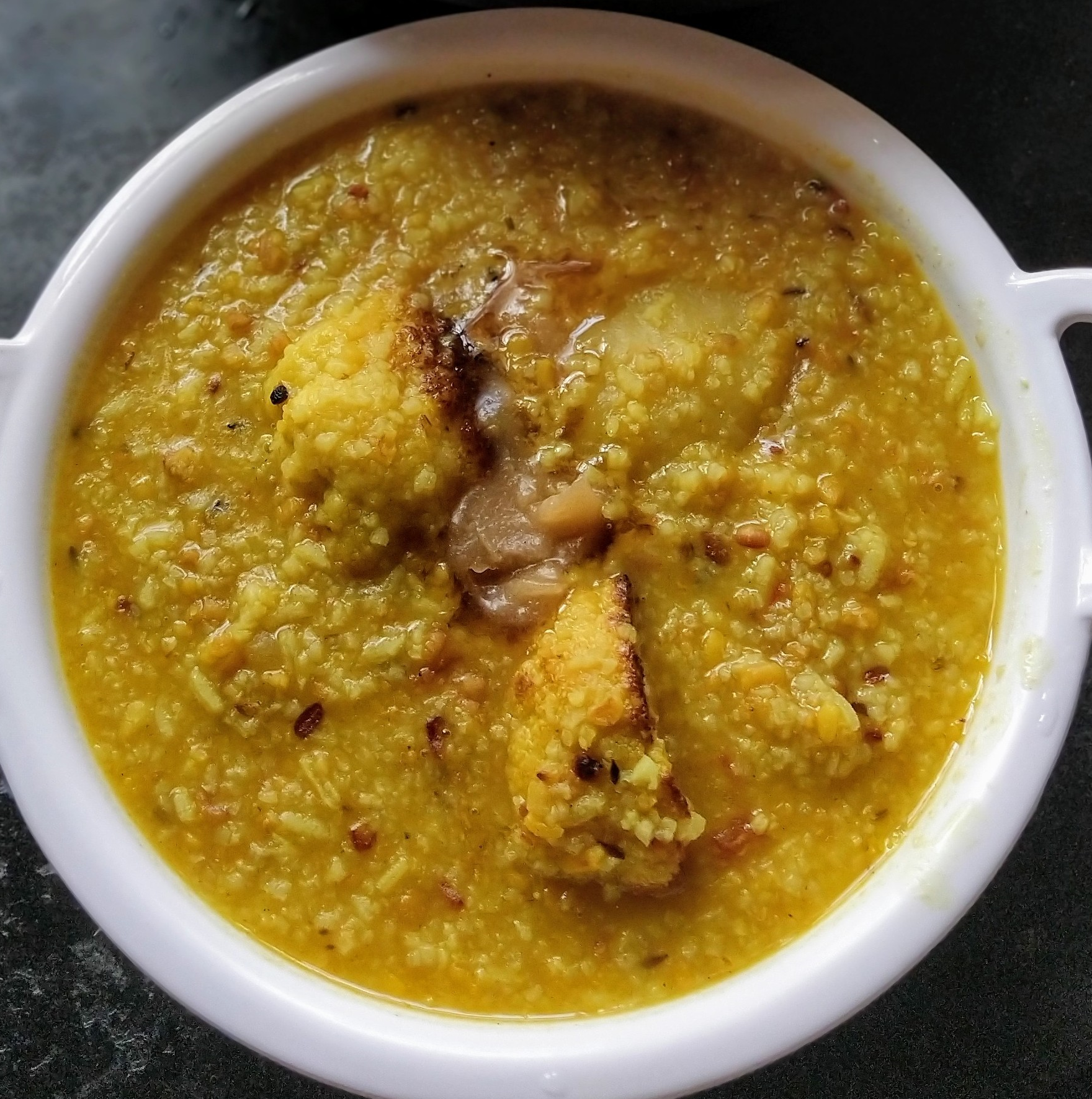
Note
The equipment & ingredient quantity provided in this recipe is to assist you in cooking this dish. Feel free to experiment with your ingredients. Remember that we all have different set, size & shape of kitchen tools in our pantry.
Equipment
- Wok or kadai
- Ladle
- Preparation and serving bowls
Ingredients
- 2 cup rice preferably gobindobhog rice
- 2 cup dal preferably split moong dal
- 1 bowl cauliflower florets cut in bigger chunks
- 2 pieces potato cut in halves
- 3 tbsp mustard oil
- 1 tbsp desi ghee
- 1 tsp whole cumin seeds
- 1 inch finely chopped ginger or half tablespoon ginger paste
- 1/2 tbsp turmeric powder
- 1/2 tsp cumin powder
- 1 tsp coriander powder
- 2 pieces green chilies
- 2 pieces medium tomatoes chopped quarterly
- 1 tbsp sugar
- salt to taste
- 15 to 20 cups hot water
Whole Garam Masala for tempering
- 2 pieces dry red chilies
- 2 pieces bayleaf
- 4 pieces peppercorns
- 4 pieces cardamom
- 1 inch stick of cinnamon
- 2 pieces cloves
Instructions
- Wash the rice repeatedly to remove the dirt and starch
- Spread the rice on a plate and allow to dry completely
- In a wok or kadai, dry roast the dal for 4-5 minutes until a beautiful aroma fills the kitchen and the dal changes color

- Separate the dal in a bowl
- Wash the dal in cold water only once
- In a wok, heat oil and fry the potatoes with a pinch of turmeric until the potato pieces of the bengali khichdi turn golden in color
- Separate the potato and proceed to fry the cauliflower florets in the same way
Cooking the Khichuri or Bengali khichdi
- Heat a wok and pour in oil
- Once the oil reaches the smoking point, temper with the spices mentioned under whole garam masala in the "ingredients" section
- Put in the cumin seeds and allow to crackle
- Throw in the chopped ginger and fry until the raw flavor is gone
- Drop in the chopped tomatoes
- Add cumin powder, coriander powder, turmeric powder
- Cook the spices till the raw smell disappears. If needed splash water to ensure that the spices do not burn
- Add in the rice and dal
- Mix and fry for a couple of minutes
- Add hot water and salt and bring to a boil
- Taste the seasoning and if required add in more salt
- Cover the wok and cook for 15 minutes.
- Check every few minutes to ensure that the dal does not stick to the bottom of the pan and get burnt. If required, add hot water
- Add green chillies and the sugar
- Cook for another 5 minutes to the desired consistency. Keep stirring to prevent the bengali khichdi from sticking to the bottom of the wok and burning
- Put off the flame
- Serve hot with fries and/or pickle
Notes
- The quantity for rice and dal should always be 1:1 for optimum flavor
- Shona mug dal is the best choice of dal while preparing khichuri
- Gobindobhog rice is the preferred variety of rice for this dish
- Do not over-wash the dal. It will lose its nutty flavor
- Always keep a jar of hot water near. You can use this to maintain the desired consistency
- Grated coconut provides the best flavors. You can substitute with desiccate coconut powder as well which is easily available in the local grocery shops
- A dollop of ghee served with a plate of hot khichuri always work wonders
The aroma increases your appetite and you feel it with every mouthful.
While a Gobindobhog khichuri is best served with a dollop of desi ghee and may not need any side dishes, Bengalis always love their plateful of khichdi with some fries. You can add in some great side dishes to the khichdi.
Basanti Pulao – Veg, Sweet & Yellow Pulao
India in 21st century thinks that a vegetarian biryani is best called a pulao. That’s sad, considering that pulao has always been associated with meat.
Don’t believe me? Ask the legendary biryani outlets in Lucknow. Chicken Yakhni Pulao is a great example.
Anyways, Basanti Pulao is the name given to a rice-based dish mostly prepared using Gobindobhog rice and served with a vegetable curry during religious occasions.
This is similar to Kanika prepared on special occasions in Odisha. Question – Is basanti pulao inspired from Odia Kanika since this has been served to Lord Jagannath at the Temple in Puri?
These days however, because of affordability, Bengalis also prepare these during special occasions like birthdays or whenever there is a guest at home. It is served with a chicken or mutton dish in such scenarios.
Check out the basanti pulao recipe.
This vegetarian pulao has a sweet taste, and a subtle, nutty and fruity aroma from the gobindobhog rice, cashews and raisins, each of which are lightly toasted in ghee.

Note
The equipment & ingredient quantity provided in this recipe is to assist you in cooking this dish. Feel free to experiment with your ingredients. Remember that we all have different set, size & shape of kitchen tools in our pantry.
Equipment
- Knife
- Wok
- Spatula
- Preparation and serving bowls/spoons
Ingredients
- 400 g Gobindobhog rice
- 2 tbsp ghee
- 16-20 pc whole cashews halved
- 8-12 pc raisins (kismis)
- 4 pc green chilies slit in half
- 2 tsp salt
- 2 tbsp sugar
- 600 ml hot water 1.5 times the amount of rice
For Marinading the Rice
- 2 tbsp ghee
- 2 inch ginger
- 2 pc bayleaf
- 2 inch stick of cinnamon (dalchini)
- 6 pc whole cardamom (elaichi)
- 4 pc cloves (lavang)
- 1 tbsp turmeric powder
Instructions
- Wash the gobindobhog rice for a couple of times to remove the dust and starch
- Soak the cashew nuts and raisins in water for an hour
- Allow the rice to dry – this can take around one hour
- Finely chop the ginger
- Once the rice is dry or at least 80-90% dry, marinade it with all the ingredients mentioned under "For the Rice Marinade" – ghee, ginger, turmeric, cloves, cinnamon, cardamom, bayleaf
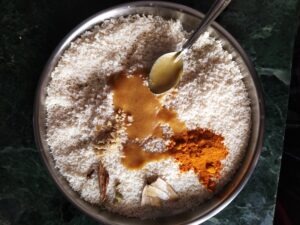
- Allow this to rest for 1 hour
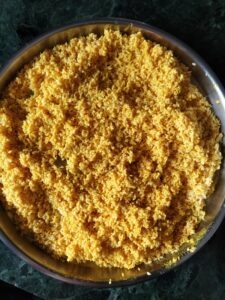
- Take a wok and add ghee
- On a medium flame, fry the cashew nuts and raisins separately
Cooking the Basanti Pulao
- In the same wok, add ghee
- Once hot, add the marinaded rice prepared in the previous steps
- On a medium flame, continuously stir the rice till the rice grains appear glassy and emits a beautiful aroma from the rice, ghee and spices
- Once you have stirred the rice for around 5 minutes, add the cashew nuts and raisins and stir for another minute
- Add hot water and cover.
- Allow this to cook for the next 15 minutes on a medium flame. You can check in between and if required add hot water
- Once the rice is 80% cooked, add the slit green chilies, salt and sugar and mix properly. There should be minimum or very less water in the wok
- Cover and allow to cook for another 2-4 minutes
- Put off the flame and allow to rest for the next 5-10 minutes
Notes
- Frying the rice is important to prevent the pulao from smelling of turmeric powder
- The amount of water to cook the pualo is an important aspect of Basanti Pulao. More water would mean a mushy pulao and less would mean a mess. To avoid this, follow the below guidelines
- Use the same measuring cup for the rice and water
- For one cup of rice, use 1.5 cups of hot water
- Using hot water is important, else your rice might turn into a lump while it cooks
- Ensure that the rice is dry after you have washed it and before marinading it with turmeric, ghee and ginger
- Do not miss out on gobindobhog rice for the optimum flavors. If gobindobhog rice isn’t available locally, use any other aromatic varieties except the basmati rice. This can include the jeera samba rice from Tamil Nadu as well.
Gobindobhog Chaler Biryani
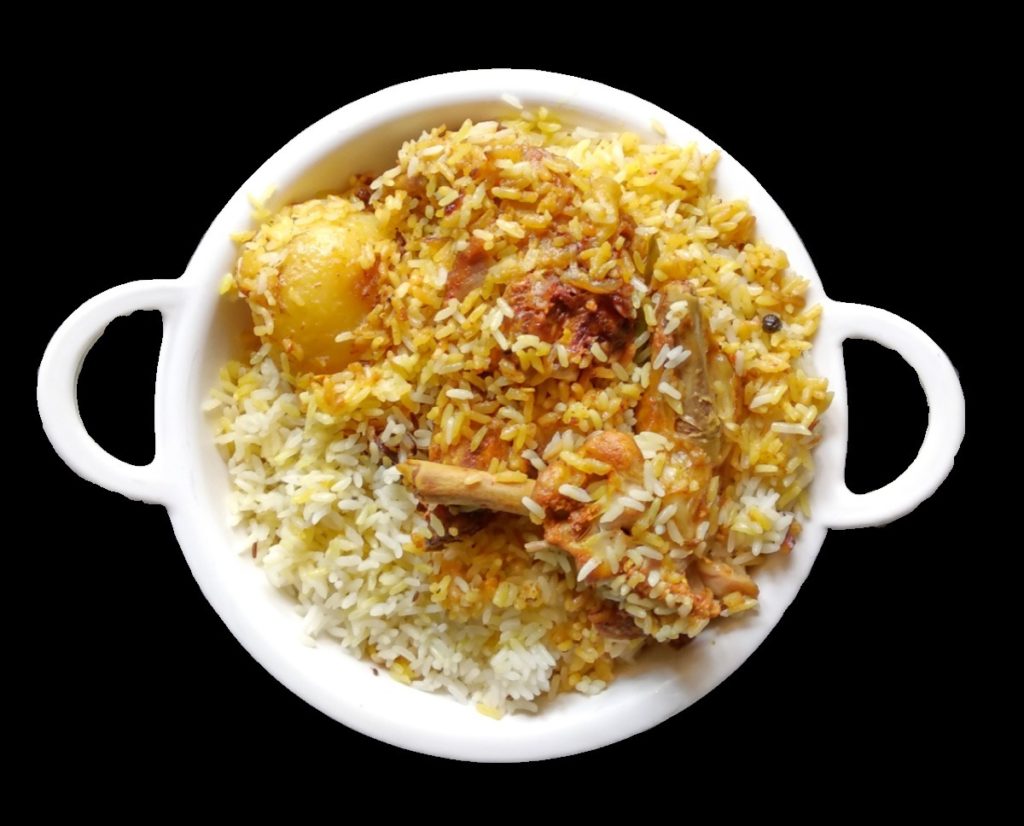
Kachhi biryani is famously associated with Hyderabad in India and Bangladesh.
While Hyderabad uses the long-grain, aromatic basmati rice, Bangladesh prepares this using kalo jeera rice.
In Kolkata and Bengal, a pakki style of biryani is prepared which is a grandchild of the Awadhi Biryani from Lucknow. The story of Kolkata chicken biryani is as interesting as the flavors in it.
This recipe is a self-creation, inspired from the biryanis mentioned above.
It combines the kachhi style of cooking with the very aromatic and flavorful gobindobhog rice.
I have documented this Gobindobhog rice biryani with a hope that more people try and love the flavors that this variety has to share.
Trust me, this is subtle, aromatic, and unique. Do give it a try!
Yakhni Pulao Using Gobindobhog Rice
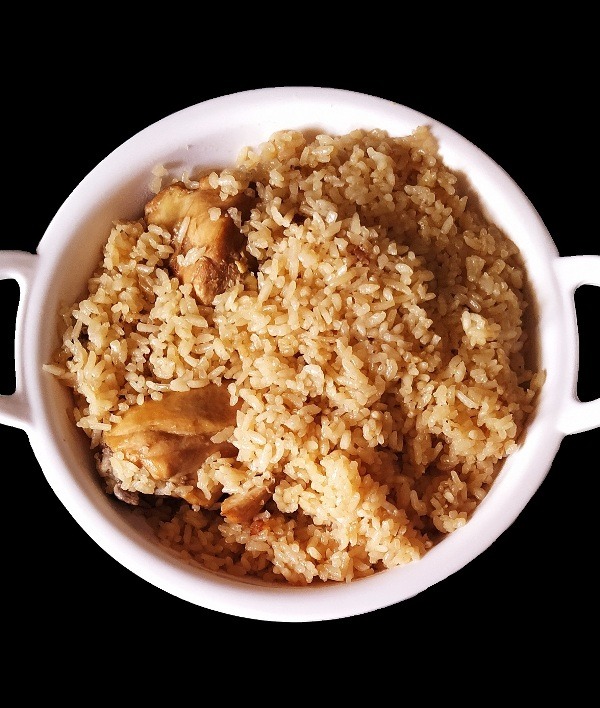
Yakhni style of cooking is a Kashmiri invention. If you did not already know, yakhni is basically a broth prepared using meat and spice.
Yakhni Pulao is cooking rice in this very flavorful broth. In India, Yakhni Pulao is mostly cooked with basmati rice.
Beyond doubt, the Indian market is filled with fake basmati rice. All long grain rice in neighborhood stores are labelled as basmati rice and even brands do not think twice before misleading the customers. If your ‘basmati’ rice does not have that subtle nutty-cum-floral aroma, it isn’t one.
I attempted the yakhni pulao using Gobindobhog rice and trust me, it is beyond drool worthy. A biryani can be good, a pulao is always better.
This pulao has magic in it – the wonderful aroma of the rice coupled with the meaty flavors of the yakhni. You can also replace the chicken with the mutton or any other meat of your choice.

Note
The equipment & ingredient quantity provided in this recipe is to assist you in cooking this dish. Feel free to experiment with your ingredients. Remember that we all have different set, size & shape of kitchen tools in our pantry.
Equipment
- Wok
- Slotted Spoon / Spatula
- Colander (optional)
- Preparation Bowls
- Knife
- Serving Bowls
Ingredients
- 2 cup Gobindobhog rice
- 2 tsp ghee
For the Brown Onions
- 4 pc medium sized onion
- 1/2 cup mustard oil
To Prepare the Yakhni
- 200 g chicken
- 2 tsp mustard oil
- 4 pc green cardamom
- 1 tsp black pepper
- 4 pc clove
- 2 pc 1-inch cinnamon or cassia
- 1 pc mace
- 1 tsp fennel seeds
- 1/2 tsp cumin seeds
- 1/2 tsp coriander seeds
- 1/3 cup well-beaten curd
- 2 inch ginger
- 6 pc garlic cloves
- 1 pc onion
- salt
- 5 cup water
Instructions
Preparation for the Yakhni Pulao [25 minutes]
- Finely slice the onions as mentioned under "For the Brown Onions"
- In a wok, add oil and allow it to reach the smoking point
- Add the sliced onions and saute till they are golden brown
- Keep separate
- Peel and roughly chop the ginger, garlic and onions as mentioned under "To Prepare the Yakhni"
- Wash the rice repeatedly to remove the dirt and starch
Preparing the Yakhni [30 minutes]
- In a wok, dry roast all the whole spices mentioned under "To Prepare the Yakhni" for a couple of minutes
- Put these whole spices in a muslin cloth and tie to prepare a potli
- In the same wok, add oil and allow the oil to smoke
- Add the roughly chopped ginger, garlic and onion and saute lightly for a minute
- Add half of the brown onions along with well-beaten curd and briskly stir
- Drop in the chicken pieces and lightly saute for a couple of minutes
- Add water and salt
- Once it comes to a boil, taste the water for saltiness. The water should taste slightly saltier. If not, add more salt and taste again. This step is very important
- Cover and allow to cook for 25 minutes
- After 25 minutes, uncover and using a slotted spoon or tong separate the chicken pieces in a bowl or plate
- Remove the spice potli and discard the contents
- Filter the water by running it through a colander to separate the liquid from the solid content. This liquid is the yakhni or chicken stock
Cooking the Chicken Yakhni Pulao [25 Minutes]
- In the same wok place the chicken pieces
- Add in 4 cups of the yakhni
- Put the flame on medium
- Add the gobindobhog rice
- Allow this to come to a boil
- Using a spatula stir it every few minutes till the water dries up and you can see holes starting to form on the rice
- Immediately lower the flame to the minimum, cover and cook it for another 10 minutes
- Uncover and add ghee
- Give this a nice stir to allow any moisture to evaporate and make the rice look drier
- Your chicken yakhni pulao is ready
- Allow the pulao to cool down before serving
- While serving, garnish with the left-over brown onions
Notes
- Buy chicken on the bone. The bones have gelatin which increases the flavor profile of the yakhni. Chicken pieces can be sized as slightly bigger than the usual curry cut pieces
- Wash the gobindobhog rice properly till the rice appears clear when in water. A lot of starch will make the chicken yakhni pulao look mushy and not give separate grains
- Never serve a pulao while its steaming hot. Pulao should be always served warm
- While I have used oil to brown the onions and saute the chicken, you can use ghee
- Do not worry if you see the curd separate when you add it while preparing the yakhni. It will even out once the yakhni is prepared
Payesh (Payasam or Rice Kheer)
If there is one recipe that is always made using Gobindobhog rice in Bengal, it has to be payesh.
Also called kheer or payasam in other Indian languages, Gobindobhog rice is the magical ingredient that can elevate this dish from great to the best.
It is the aroma of the rice coupled with the extra starch content that makes the dish worth craving for. And if it is winter, the date palm jaggery substitutes the sugar in the payesh to provide the much needed warmth during the winter months of December and January.
Here’s the recipe video by BongEats for nolen gurer payesh (Rice kheer using date palm jaggery)
Muri Ghonto
Bengal has always been a land of frugality. Since the region has seen droughts, famines, floods and partition, the general population has always made the most of every ingredient available.
Murighonto is one such dish. While the urban population might discard the head and tail of the fish, Bengalis use them in a number of ways.
When the fish head is cooked with flavorful gobindobhog rice, vegetables like potatoes, and an array of spices it results in a mish mash which is lovingly called murighonto; where ‘muri’ is the head of the fish and ‘ghonto’ is a generic bengali term for mish-mash curries.
The dish has a complex flavor profile. On one hand you have the melt in mouth gelatin from the fish, and on the other hand the flavors from the vegetables. On one hand you get a feel of the spices that are not harsh on your palette, and on the other you feel the aroma from the use of gobindobhog rice.
Murighonto is a curry that you can serve with rice. Be careful of the sharp bones in the head though. Surely, this is a must try once in a lifetime.
Once you understand the depth of the flavors, you will come back to it every time. Check out the recipe by Rumki’s Golden Spoon.
Buy Gobindobhog Rice Online
If you stay in Bengal you will get this variety of rice in your nearest grocery stores.
If you are staying in Odisha, there are high chances that you will get the rice in select stores. However, be careful! Make sure that you sniff the aroma of the rice before you buy. I have faced a couple of situations where the seller had passed off a different variety of similar looking rice as gobindobhog.
The rice is also available in many stores across cities of India and abroad that has a considerable Bengali population. However, do perform the sniff test for quality checks.
In case you are not able to get your hands on the rice, here are a few links to help you procure the same.
The Last Words on Gobindobhog Rice
Gobindobhog rice is beyond doubt a versatile variety grown in Bengal.
The rice is used most widely at home and very rarely at restaurants. There is a huge scope to innovate on recipes that otherwise uses basmati rice or other long grain rice.
Perhaps restaurants can start with a varieties of pulaos and biryanis that are most in demand among the population today.
If you have an interesting recipe using Gobindobhog rice that you would like to share with me, please drop a line in the comment sections.
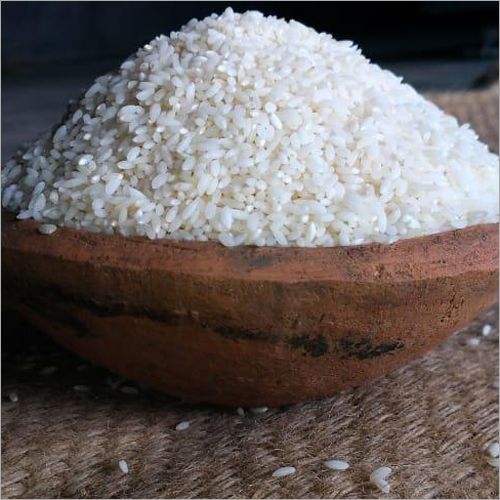

Thank you for sharing this. And I must say that biryani using Gobindobhog rice is very unique – something that I had not heard before, will surely give this a try